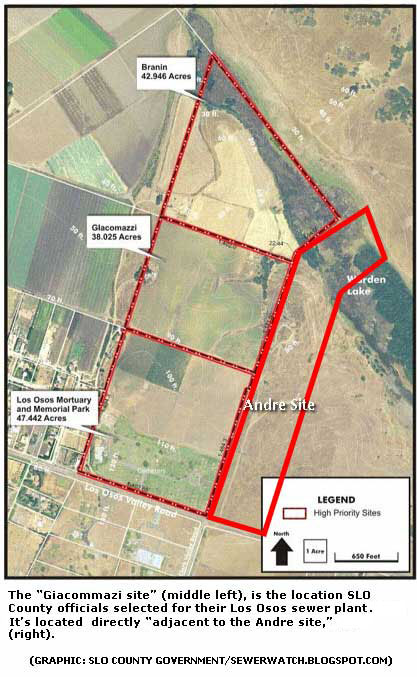Would the Coastal Commission Still Have Approved the Tri-W Disaster in 2004, Had the Los Osos CSD Not Lied to Them?
[Note: Sara Wan is the current "Chair" of the California Coastal Commission. She was also a member of the Commission in 2004, when they approved the development permit for the now-failed Tri-W disaster -- a horrific decision, with horrific consequences -- which makes Wan the perfect recipient for the following email.]
Dear Commissioner Wan,
I think you are going to find this e-mail extremely interesting, and the reason I'm writing it to you is because, as you'll see, you are one of a tiny handful of people that can answer my question.
I recently wrote, and then published, a story on my blog, at this link:
http://sewerwatch.blogspot.com/2011/03/seven-disastrous-years-later-countys.html
... that shows (with links to primary sources, as usual) that the 2004 Los Osos CSD, and its engineers, had sitting on their desks in 2004, a wastewater project ("Exhibit 3-C") for Los Osos that was/is nearly identical to the project that SLO County officials just spent four years and some $8 million developing, and that you, and your fellow Commissioners, approved back in June of 2010, which includes major components like a sewer plant located east of town (on property directly "adjacent to the Andre site"... the "Giacomazzi" site), a "gravity" collection system, a small "pumping station" at the Tri-W site, and disposes "effluent" at a location called "the Broderson site."
As you probably recall from 2004's 3-C, that's the near-identical description of the 2004 LOCSD's "alternative" (to the Tri-W disaster), that they didn't use.
District engineers developed "Exhibit 3-C" at the request of the Coastal Commission, when the Commission asked the District (in May of 2004) to "evaluate whether parcels adjacent to the Andre site [bolding mine] provide a feasible opportunity to reduce potential project impacts."
As you also know, in 2004, instead of pursuing the (presumably) correct project -- Exhibit 3-C, with an out-of-town (and downwind) sewer plant, at the "environmentally superior alternative," "adjacent to the Andre site," and nearly identical to the county's currently approved (by you) project -- the 2004 LOCSD, and its engineers, opted to pursue their now-failed (after 11-years-and-counting of delay, and some $25 million), "infeasible" (county's word), colossally disastrous, laughably embarrassing, "mid-town," sewer plant/"picnic area" (on ESHA), "bait and switchy" (Coastal Commissioner's words) Tri-W... disaster.
Additionally, I also first exposed on my blog in 2005, at this link, how Los Osos CSD officials and its engineers (The Wallace Group, and Montgomery, Watson, Harza) deliberately (repeat: deliberately) left out millions of dollars worth of project components from the cost estimates for the Tri-W disaster, and then concluded in 3-C, "There does not appear to be any economic incentive to relocate the WWTF from the Tri-W site to (a site adjacent to the) Andre site."
And that was that -- those deliberately low-balled numbers (directly to the California Coastal Commission, I will point out) by the Los Osos CSD and its engineers in 2004, in Exhibit 3-C, appears to be the SOLE reason why the "environmentally superior" sewer plant location "adjacent to the Andre site," wasn't used in 2004 (instead of in 2011-and counting), because had the District and its engineers not fudge their numbers (to you, and your fellow Commissioners) in 3-C, in 2004, there, it certainly appears, would have been a lot of "economic incentive to relocate the WWTF from the Tri-W site to (a site adjacent to the) Andre site," as the county, and you, have now clearly concluded... in 2010... six years after 3-C... is the way to go.
As you probably also know, $8 million and four years of county analysis also reveals the following about the now-failed Tri-W disaster [bolding mine]:
- "(Tri-W's) downtown location (near library, church, community center) and the high density residential area require that the most expensive treatment technology, site improvements and odor controls be employed."
and;
- "It has high construction costs..." ($55 million. The next highest treatment facility option is estimated at $19 million.)
and;
- "Very high land value and mitigation requirements"
and;
- Tri-W energy requirements: "Highest"
and;
- "Small acreage and location in downtown center of towns require most expensive treatment"
and;
- "higher costs overall"
- - -
And all of that brings me to my question:
Had the 2004 Los Osos CSD not lied to you, and your fellow Commissioners, by deliberately low-balling their numbers in Exhibit 3-C, and therefore erroneously (on purpose) concluding that there was no "economic incentive" to pursue the correct, "environmentally superior" project for Los Osos (according to four years and $8 million worth of county analysis) in early 2004, would you still have voted to approve the Tri-W "project" in August of 2004?
Thank you very much for your time,
Ron
P.S. I thought this e-mail would be of interest to my readers, so I published it on my blog:
sewerwatch.blogspot.com
Thanks again
Dear Commissioner Wan,
I think you are going to find this e-mail extremely interesting, and the reason I'm writing it to you is because, as you'll see, you are one of a tiny handful of people that can answer my question.
I recently wrote, and then published, a story on my blog, at this link:
http://sewerwatch.blogspot.com/2011/03/seven-disastrous-years-later-countys.html
... that shows (with links to primary sources, as usual) that the 2004 Los Osos CSD, and its engineers, had sitting on their desks in 2004, a wastewater project ("Exhibit 3-C") for Los Osos that was/is nearly identical to the project that SLO County officials just spent four years and some $8 million developing, and that you, and your fellow Commissioners, approved back in June of 2010, which includes major components like a sewer plant located east of town (on property directly "adjacent to the Andre site"... the "Giacomazzi" site), a "gravity" collection system, a small "pumping station" at the Tri-W site, and disposes "effluent" at a location called "the Broderson site."
As you probably recall from 2004's 3-C, that's the near-identical description of the 2004 LOCSD's "alternative" (to the Tri-W disaster), that they didn't use.
District engineers developed "Exhibit 3-C" at the request of the Coastal Commission, when the Commission asked the District (in May of 2004) to "evaluate whether parcels adjacent to the Andre site [bolding mine] provide a feasible opportunity to reduce potential project impacts."
As you also know, in 2004, instead of pursuing the (presumably) correct project -- Exhibit 3-C, with an out-of-town (and downwind) sewer plant, at the "environmentally superior alternative," "adjacent to the Andre site," and nearly identical to the county's currently approved (by you) project -- the 2004 LOCSD, and its engineers, opted to pursue their now-failed (after 11-years-and-counting of delay, and some $25 million), "infeasible" (county's word), colossally disastrous, laughably embarrassing, "mid-town," sewer plant/"picnic area" (on ESHA), "bait and switchy" (Coastal Commissioner's words) Tri-W... disaster.
Additionally, I also first exposed on my blog in 2005, at this link, how Los Osos CSD officials and its engineers (The Wallace Group, and Montgomery, Watson, Harza) deliberately (repeat: deliberately) left out millions of dollars worth of project components from the cost estimates for the Tri-W disaster, and then concluded in 3-C, "There does not appear to be any economic incentive to relocate the WWTF from the Tri-W site to (a site adjacent to the) Andre site."
And that was that -- those deliberately low-balled numbers (directly to the California Coastal Commission, I will point out) by the Los Osos CSD and its engineers in 2004, in Exhibit 3-C, appears to be the SOLE reason why the "environmentally superior" sewer plant location "adjacent to the Andre site," wasn't used in 2004 (instead of in 2011-and counting), because had the District and its engineers not fudge their numbers (to you, and your fellow Commissioners) in 3-C, in 2004, there, it certainly appears, would have been a lot of "economic incentive to relocate the WWTF from the Tri-W site to (a site adjacent to the) Andre site," as the county, and you, have now clearly concluded... in 2010... six years after 3-C... is the way to go.
As you probably also know, $8 million and four years of county analysis also reveals the following about the now-failed Tri-W disaster [bolding mine]:
- "(Tri-W's) downtown location (near library, church, community center) and the high density residential area require that the most expensive treatment technology, site improvements and odor controls be employed."
and;
- "It has high construction costs..." ($55 million. The next highest treatment facility option is estimated at $19 million.)
and;
- "Very high land value and mitigation requirements"
and;
- Tri-W energy requirements: "Highest"
and;
- "Small acreage and location in downtown center of towns require most expensive treatment"
and;
- "higher costs overall"
- - -
And all of that brings me to my question:
Had the 2004 Los Osos CSD not lied to you, and your fellow Commissioners, by deliberately low-balling their numbers in Exhibit 3-C, and therefore erroneously (on purpose) concluding that there was no "economic incentive" to pursue the correct, "environmentally superior" project for Los Osos (according to four years and $8 million worth of county analysis) in early 2004, would you still have voted to approve the Tri-W "project" in August of 2004?
Thank you very much for your time,
Ron
P.S. I thought this e-mail would be of interest to my readers, so I published it on my blog:
sewerwatch.blogspot.com
Thanks again



